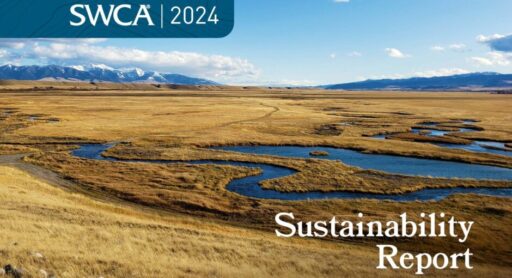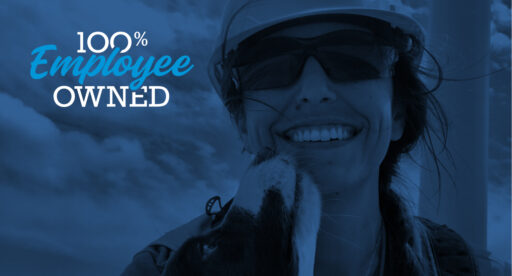2025
Comparably’s Best Company Outlook
* Providing engineering services in these locations through SWCA Environmental Consulting & Engineering, Inc., an affiliate of SWCA.

From the experts we hire, to the clients we partner with, our greatest opportunity for success lies in our ability to bring the best team together for every project.
That’s why:

At SWCA, sustainability means balancing humanity’s social, economic, and environmental needs to provide a healthy planet for future generations.

SWCA employs smart, talented, problem-solvers dedicated to our purpose of preserving natural and cultural resources for tomorrow while enabling projects that benefit people today.

At SWCA, you’re not just an employee. You’re an owner. Everyone you work with has a stake in your success, so your hard work pays off – for the clients, for the company, and for your retirement goals.
Proposed Removal of “Harm” Definition from Endangered Species Act Regulations
Amanda Glen is SWCA’s natural resources technical director for biological services and provides strategic guidance on permitting and compliance for matters involving protected wildlife, plants, and habitats. Currently managing a national practice, she has more than 25 years of consulting experience with an emphasis on the Endangered Species Act (ESA) and how compliance with the ESA influences other regulatory programs. Her wealth of experience pertaining to endangered species issues includes research, permitting, consultations, status reviews, and conservation planning. Her experience includes negotiating compliance solutions for critically imperiled species facing potential determinations of jeopardy or adverse modification of designated critical habitats. She has led efforts to delist species no longer requiring the protections of the ESA when supported by sound science, and has been involved in voluntary conservation planning to help preclude the need to list species. Amanda frequently presents at regional and national conferences on matters related to the ESA, including new listings, regulatory and policy changes, and trends in compliance strategies.


The U.S. Fish and Wildlife Service and National Marine Fisheries Service (the Services) have jointly proposed removing the definition of “harm” from regulations implementing the Endangered Species Act (ESA).
As stated in the proposal:
“The existing regulatory definition of ‘harm,’ which includes habitat modification, runs contrary to the best meaning of the statutory term ‘take.’ We are undertaking this change to adhere to the single, best meaning of the ESA.”
The ESA prohibits “take” of endangered wildlife, defining it as to “harass, harm, pursue, hunt, shoot, wound, kill, trap, capture, or collect, or to attempt to engage in any such conduct.” Under current implementing regulations, “harm” includes habitat modification that significantly impairs behavioral patterns (like breeding or sheltering) and results in injury or death.
In practice, harm via habitat modification is one of the most common forms of take addressed in ESA consultations and permitting. The proposed rule indicates a potential shift by the Services toward a more limited interpretation of “harm”—and possibly “take” overall. Ultimately, the courts determine the “single best meaning” of the statute when the language is unclear.
While the Services do not propose a replacement definition, they reference a 1995 dissenting opinion by Supreme Court Justice Scalia. He asserted that “take” should be interpreted based on its historical meaning: to “kill or capture” a wild animal.
This could mean the ESA would only prohibit direct actions against wildlife, with habitat modification only qualifying as take if it occurs during such direct actions. This marks a significant narrowing from the current view, where take includes indirect impacts to wildlife behavior.
If finalized, this change may limit the need for incidental take permits for land use activities that are not directly targeted at wildlife but may still alter their behavior or habitats. Although the Services appear to be moving in the direction of limiting the circumstances that constitute harm and take, it will be up to the courts to decide the meaning of the statute.

Endangered Everglade Snail Kite
The Services suggest that future activities—particularly those indirectly affecting ESA-listed species—may not require incidental take authorization under this revised interpretation.
For federal actions, habitat modification could still trigger formal interagency consultation. However, biological opinions may no longer include incidental take statements or require conservation measures tied to habitat impacts, potentially reducing the scope of ESA compliance obligations for some projects.
According to the Services, this change would apply only to future actions (including those currently under review). Existing permits and regulatory assurances would remain valid. However, the final rule may offer a path for project proponents to amend current authorizations if desired.
The Services have not proposed a new definition for “harm” and do not intend to. However, they may issue future guidance if the rule is finalized.
The courts will ultimately establish the meaning of take under the ESA and whether harm via habitat modification is a prohibited action, but resolving this question may take years to materialize. Court interpretations may also vary across jurisdictions, potentially leading to regional differences in how ESA take is defined and enforced.
The public comment period for the proposed rule ends May 19, 2025, after which the Services may issue a final decision. Given their asserted alignment with prior legal opinions and executive direction, final action may move quickly.
View and Comment on the Proposal.
SWCA can help you consider how to move forward with your projects in this uncertain environment and balance project risks and opportunities. Our regulatory specialists and project managers are tracking these developments and bringing insights from diverse project types and client needs.